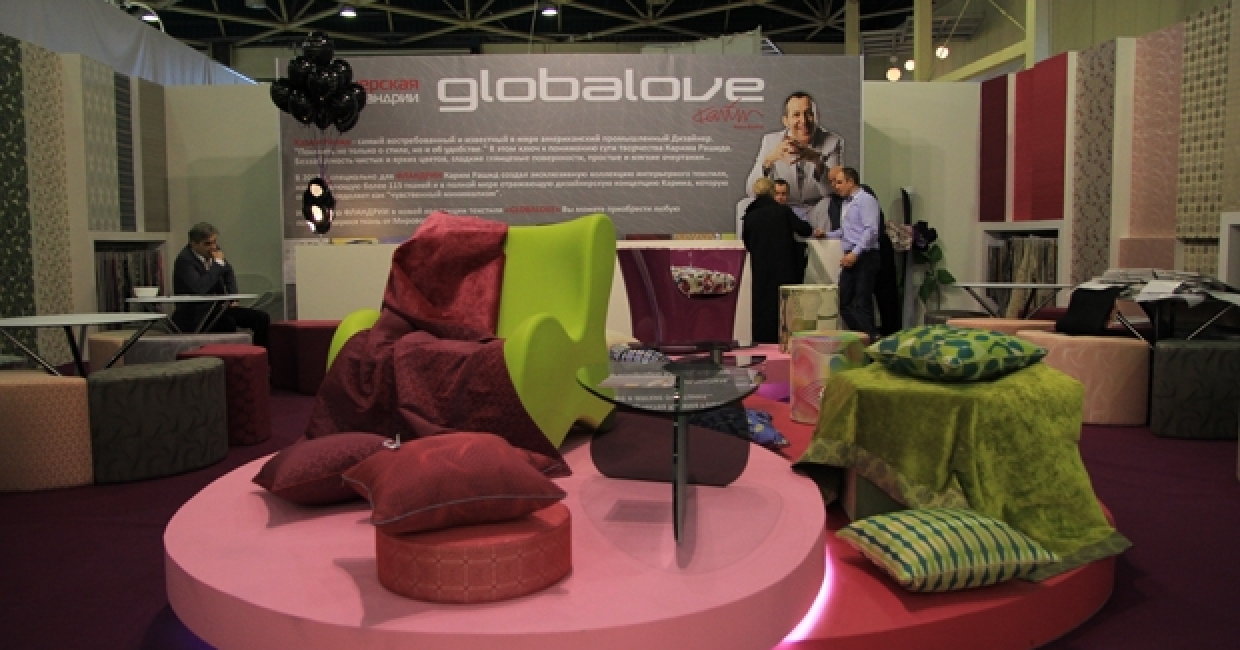Trade between Russia and the UK is relatively low – according to FIRA’s recent Statistical Digest, exports to Russia comprised only around 2% of the UK’s total. Consequently, there is real potential for manufacturers of both domestic and commercial furniture – initiatives such as the BFM’s recent Exclusively British exhibition in Moscow are opening doors for UK exporters, and the changing economic landscape of the federation promises to heighten this potential in the near future. In this article, Mebelny Biznes magazine's Artem Vasiliev outlines the characteristics of the Russian furniture industry, and explores some of its key players.
The Russian furniture industry has got the better of the recession – in 2011, production volume exceeded the pre-crisis level of 2008, at current prices. According to the national furniture association AMEDORO, the year-to-year increase amounted to about 13%, and the production volume was 6% higher.
It is significant to note that two ways of calculation are used for the Russian macro-economy – the first is based on official data, but since the so-called ‘shadow’, or black market production share is always large in the Russian market (in many sectors, including furniture), it is important to take it into account. AMEDORO’s assessment also takes into account some indirect activities – such as the performance of the chipboard industry – and publishes the results together with the officially processed data.
Comparing these figures, one can conclude that the shadow economy sector of the Russian furniture market is growing much faster than the official one. Thus, the furniture production volume reached 107.22b rubles (RUB) – around US$3.65b – in 2011 at current prices according to the official data, while the estimated shadow sector adds some RUB 80b – US$2.75b – to this.
“When it comes to furniture and not oil, the Russian Federation is not an export-oriented country”
The volume of imports is constantly growing, after a 30% gap in 2009, reaching US$2.963b in 2011, according to official statistics. Its growth rate (+35% year-to-year) is much faster than that of domestic production.
In 2011, imports accounted for more than half (54.9%) of the Russian furniture market, or 40.2% when taking into account the shadow production. In spite of considerable import duties, the volume of imports of low-priced furniture is growing at an even faster pace – +58.5% for the furniture priced less than 1.8€/kg). Such products – principally from China, which now covers more than 20% of Russia’s entire furniture imports – compete directly with the furniture of the majority of Russia’s domestic producers.
As the dynamics show, the game’s success is on the side of imports. When it comes to furniture and not oil, the Russian Federation is not an export-oriented country. Currently, most of the local players are not ready to enter foreign markets, especially those far abroad. This is why the export volume is low – US$214.5m in 2011 – and the trade balance is more than negative. This is one of the key problems for Russian furniture manufacturers right now – development of the country’s export potential remains a burning issue for them.
Regional markets
Russia’s Central Federal District had the largest share (38.6%) of domestic furniture production last year, followed by Volga Federal District (27.0%) and the Northwestern Federal District (11.3%). This is the usual balance of power of the geographic strata for the Russian furniture industry. In general, the regional production ranking also reflects the local furniture consumption trends.
Comparing these figures with the population charts, one can discover the as-yet undeveloped potential of specific areas. For example, the Siberian Federal District ranks third by population, but only fifth when it comes to furniture production. In 2011, the highest production dynamic was detected in the North Caucasian area (+30.9%). Its growth rate is attributed to the subsidised character of regional economy – these areas are mostly supported by the country’s federal budget – and to the common process of Caucasian industrialisation.
The Volga area shows its usual positive trend, with 22.2%. The other districts more or less match the average national growth. In the meantime, the performance of the Southern District regions that were supposed to be meeting the needs of the upcoming 2014 Winter Olympics in Sochi is not that eminent yet – +3.3% in 2011.
Aiming to reach more local consumers, furniture producers have increased their wholesale network, reaching new dealers from specific cities. After Moscow, they usually proceed with the largest cities, with populations of more than one million – St Petersburg, Novosibirsk, Yekaterinburg, Nizhniy Novgorod, Samara, Kazan, Omsk, Chelyabinsk, Rostov-on-Don, Ufa, Volgograd, Perm and Krasnoyarsk.
At the same time, the regionally-oriented manufacturers do their best to offer a more convenient logistical service, by opening regional warehouses in the most reachable places. The focus on distribution through dealers of different sizes – independent retailers with one or two sales points, local trade networks with several stores in the region, and large-scale federal networks operating all over the country – is a usual way of marketing for Russian manufacturers.
Some manufacturers maintain their own retail stores near their industrial base, using them as a test platform for new products or to find a better balance of sales during the seasonal peaks and troughs. With regard to the untapped regions, a factory may concentrate developing its own retail network there – but only when the product is too complicated, or the target group too narrow, for the average multibrand furniture seller.
WTO prospects
As to the development prospects in the near future, the consequences of Russia’s entry into the World Trade Organization last summer – after an 18-year negotiation process – are expected to be a key factor. During the next six years, the custom duties are expected to drop – according to estimates by AMEDORO, today’s 41.7% duty for low-priced imported furniture will gradually be reduced to 12.8% by 2018.
The new rules will be a challenge both for Russian companies discovering themselves on the open market for the first time, and for foreign players entering this rapidly-developing, high potential area.
The picture today
According to Artem, most of today’s successful Russian furniture enterprises produce cabinet furniture – mainly from chipboard or MDF, rather than solid wood. ”There are just a few upholstery producers among the leaders,” he says, “because the sofa sector suffered the most during the last economic crisis, and hasn’t improved since.
“In fact, upholstery is the only furniture sector in Russia which is completely dictated by the trade itself – with regards to design, functionality and prices.
“On the other hand, the success of the mattress sector is absent from any forecasts – the mattress company Askona seems to be not only the leader in that sector, but also the highest-selling company altogether in Russia’s furniture market.
“Some experts assume that the delayed demand which drove strong furniture sales during the post-crisis years is finally saturated”
“According to the most recent data from AMEDORO, for the first three quarters of 2012 national furniture production grew by 12.5% in fixed prices, and reached RUB 87.9b (or US$2.8b) in the period from January to September. The dynamics in the first half of the year was highest – up 14.9%.
“The special feature of the past year is that the usual surge of demand in the autumnal season was not experienced by most of the market players – the curve of sales was much more smooth than in previous years, and some experts assume that the delayed demand which drove strong furniture sales during the post-crisis years is finally saturated.
“Regardless, the trade dynamic remains higher than anywhere westward in Europe, so the market is very interesting for foreign players – the imports volume continues to grow within every furniture category (+18.1% in January-through-September).”
According to recent data from the Russian Customs Committee, in 2011 the UK ranked 21st in Russia’s import sources, accounting for US$35.11m (0.9%) of its total. The volumes in 2010 and 2009 were US$26.31m (1%) and US$20.34m (1.1%) respectively. However, while the UK’s import value to Russia is increasing each year – by an impressive 33.5% in 2011 – its share relative to Russia’s total furniture import value has decreased a little.
Key manufacturers
• Lazurit, a manufacturer and retailer of cabinet furniture from Kaliningrad, which enjoyed a turnover of around US$280m in 2012
• Askona – the Russian division of Hilding Anders mattress holding, boasted a turnover of around US$210m in 2011. However, the success of the mattress sector is absent from any forecasts – Askona appears to be not only the leader in that sector, but also one of the highest-selling companies in Russia’s furniture market altogether
• Maria, a kitchen manufacturer from Saratov, turned over around US$180m in 2011
• Stolplit, the producer of the cheapest cabinet furniture on the market
• Shatura, which enjoyed a turnover of around US$160m in 2011 – excluding sales from its large Russian retail network – is one of the best-known cabinet furniture producers, with a large line-up of trademarks in different price segments
• Angstrem, from Voronezh city, one of the most ambitious manufacturers of cabinet furniture in the middle market sector, turned over around US$110m in 2012, and is planning to reach US$330m in 2014
• Almaz/LubiDom, the closest competitor of VKDP, with a similar approach to large-scale series manufacturing, based in the same city, selling furniture at a slightly higher price. It turned over approximately US$100m in 2012
• VKDP/TriYa, an enterprise from Volgodonsk in the south of Russia, is part of the new wave of furniture producers of low-cost cabinet furniture, turned over around US$66m in 2010
• Lerom, another cabinet furniture maker, from Penza, found success with classical-style furniture, mostly in the regional areas of Russia, turned over around $US70m in 2011
• Katyusha/Dyatkovo/Dmi, a cabinet furniture maker from Dyatkovo in the Bryansk region, turned over around US$40m in 2011
• Ronikon, a cabinet furniture maker from the Moscow area, specialises in cupboards and wardrobes, providing some of the cheapest in Russia, turned over US$33m in 2010
• Moon/Zhiviye Divany, a sofamaker from the Moscow area
Events
Mebel (the key event, between 18th-22nd November 2013, Expocentre Fairgrounds, Moscow)
Moscow International Furniture Fair/Rooms Moscow (MIFS, 21st-25th May 2013, Crocus Expo International Exhibition Center)
EEM/Euroexpofurniture (13-16th May 2013, Pavilion 75 at VVC, Moscow)
Author Artem Vasiliev is the foreign editor of Mebelny Biznes magazine, the Russian member of the International Alliance of Furnishing Publications (IAFP). Main article reproduced courtesy of World Furniture, International Markets Review magazine.









